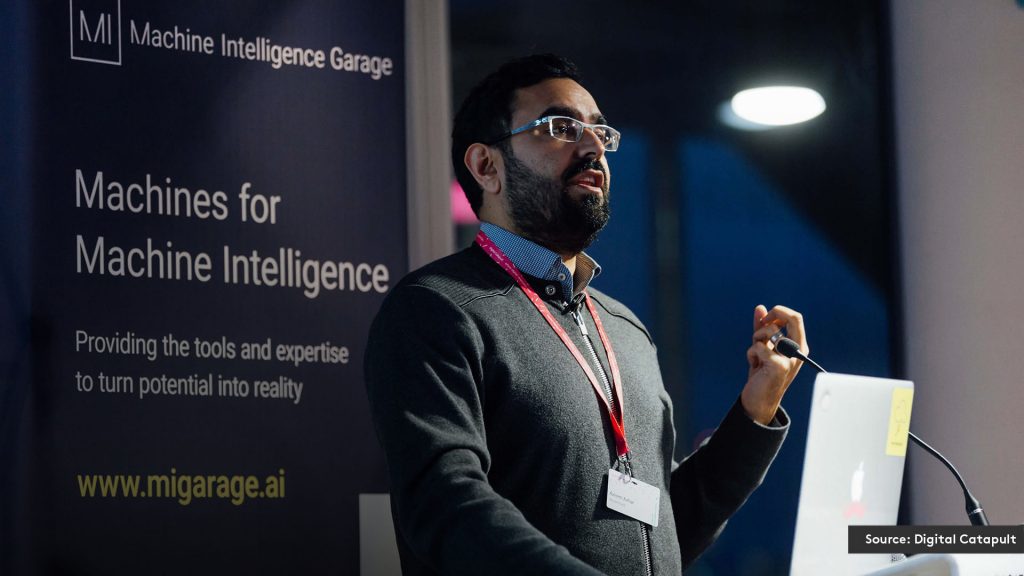Key Takeaway
We sat down with Azeem Azhar, Senior Advisor for AI to the CTO of Accenture, startup adviser and the voice behind the highly acclaimed Exponential View newsletter. Azhar previously founded PeerIndex (acquired by Brandwatch), has invested in more than 20 technology companies, and has worked with Reuters, BBC, The Economist and The Guardian.
Azhar gave us his take on why now is the time for the AI revolution and what we’re getting wrong about the AI hype.
Why AI, why now?
Artificial intelligence in and of itself is by no means a new technology. But today we’re experiencing rapid deployment of AI across almost every sector, and finding new use cases for the technology that are changing the way we do business and make decisions.
“Big picture – the confluence of data from both internal and external systems, with rapidly improving processing power, has enabled us to get utility out to a range of new algorithms and algorithmic approaches,” Azhar said. “The headline story is around the deep neural networks and deep learning which are dependent on a lot of data and on a lot of processing power being a technique that we can use.”
According to Azhar, three things have come together today that have made now the perfect time for AI to take off: computational power, massive amounts of data and networks to learn from.
“That fundamental driving enabler is what we’re seeing with breakthrough applications in AI. We couldn’t have had this conversation 5 years ago because none of these things worked.”
Access to massive amounts of data and new data types is key to our ability to create and feed the algorithms that we begin to rely on to inform better decisions. “If you think about how much data is required – you need to provide millions of examples for a neural network to recognize something.”
Why is AI adoption moving so quickly?
Today we’re seeing rapid deployment of AI across verticals as more decision makers begin to understand where it can impact their businesses. According to Azhar, this is the result of three key factors:

1. The world has moved over the course of the years to a programmatic and digital environment; companies even in physical industries like logistics and transport have software applications for their businesses.

2. Any company can deploy a new AI model in the cloud and can scale these offerings out quickly to large numbers of people.

3. We are flat, highly communicative and collaborative both in terms of research and how firms share and announce their breakthroughs in an environment where everyone knows there is a race.
This proliferation of information and shared learnings, combined with easy access to AI and cloud-based technology has enabled the rapid deployment of AI applications, from startups in the space carving out niche solutions to large incumbents looking to use AI innovation to secure their place at the top of their industries.
“As a result, companies are getting very rapid ROI when they’re thinking about deploying AI. Payback periods are very fast. We’re also starting to see that the largest companies in the world – Amazon, etc – have at their heart AI systems that are creating barriers of entry in their markets.”
In his book Outside Insight, Meltwater Founder & CEO Jorn Lyseggen identified similar macro trends he believes are driving this development: “exponential growth of cloud-based computing power, exponential advances in artificial intelligence and exponential growth of external data.” According to Lyseggen and Azhar, these trends are paving the way not just for AI innovation but specifically for the proliferation of external data analysis. “Together these trends will converge to create Outside Insight software with staggering capabilities,” Lyseggen said.

Misconceptions about AI: what are we getting wrong?
Azhar identified three key areas where we’re seeing companies potentially approaching AI transformation incorrectly.
1. Settling for incremental improvements rather than bringing AI into the core of the business
In an effort to capitalize on the growing trend in AI deployment, companies are often settling for small improvements to individual areas within their businesses, as opposed to bringing AI innovation into their core. “They’re focusing on cost optimization rather than a much harder question: how does this actually, fundamentally change my business?”
For instance, a starting point in terms of incorporating AI for a lot of companies might be to put a chatbot in over their customer service applications. “They will see incremental improvements in their customer service metrics, reduced costs, etc. But that’s very much the periphery of the business, not the heart of the business,” Azhar said.
Alternatively, it’s those tech companies that have AI at their core that are really leveraging the possible ROI from this technology. “Apple, Google, Facebook – they make their money not through optimizing customer service channels but because sitting at the middle is a digital network run primarily on AI.”
A recent study by Gartner projects that the value of AI-derived businesses will reach $3.9 trillion in 2022. Echoing Azhar’s predictions, John-David Lovelock, research vice president at Gartner, said, “AI promises to be the most disruptive class of technologies during the next 10 years due to advances in computational power, volume, velocity and variety of data, as well as advances in deep neural networks (DNNs).”
2. Relegating AI innovation to a siloed team within the organization
Bringing AI innovation into the core of the business means that all teams across the organization need to embrace it as the way forward, and understand ways in which the technology can help them do their jobs better.
“Companies think that they can bring in AI by hiring a siloed team and trying to put something together.” Alternatively, looking at wider trends in the industry, often “they believe that the technology is so advanced now that they can’t compete at all, when in reality, while the tech that’s really at the cutting edge is hard, the stuff that looked like magic four years ago is everyday technology today.”
3. That AI always = super intelligence
“There’s this idea of products running amok and creating super intelligence, which isn’t a real thing for most firms,” Azhar said.
The myth of a superhuman or superintelligent AI is analyzed in a great piece in WIREDby Kevin Kelly. In evaluating the most common assumptions behind the argument that “AIs will become so much smarter than us they will take our jobs,” Kelly posits that “buried in this scenario of a takeover of superhuman artificial intelligence are…assumptions which, when examined closely, are not based on any evidence. These claims might be true in the future, but there is no evidence to date to support them.”
In other words, this should not be a fear worthy of preventing firms from adopting any sort of AI innovation today. On the contrary, those who do not will soon lose their competitive advantage to innovators making bigger leaps in the field.
What happens next?
In the Exponential View podcast, in conversation with Jason Pontin, editor of MIT’s Technology Review, Azhar discusses new technologies and our ability to potentially control how they spread. His concern, however, is around the fact that in essence, AI is widely accessible. “Nuclear power, [for instance], was extremely expensive, and these technologies are very cheap. Proliferation is harder to manage when it’s a zero cost thing.”
“Can technology be controlled?” Pontin asks. “Probably not but we can slow and control it. Like a river, to some degree….In the end we have to have a measure of cautious optimism that technology solves big problems, expands human possibilities and grows wealth.”
In order to keep its growth in check, Azhar posits, we need to be constantly, actively educated. “There’s an inevitability around the technological progress. It’s a driver of so many of the good and more costly things that are happening, and in order for us to do this we need to actively engage in a conversation. It’s better to be a participant than to be a spectator. That means reading about it, engaging.”

